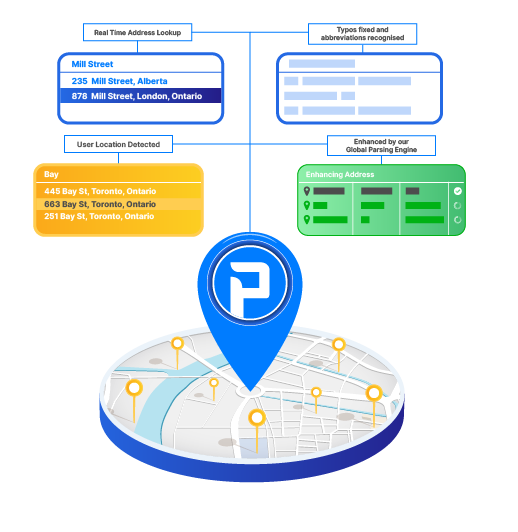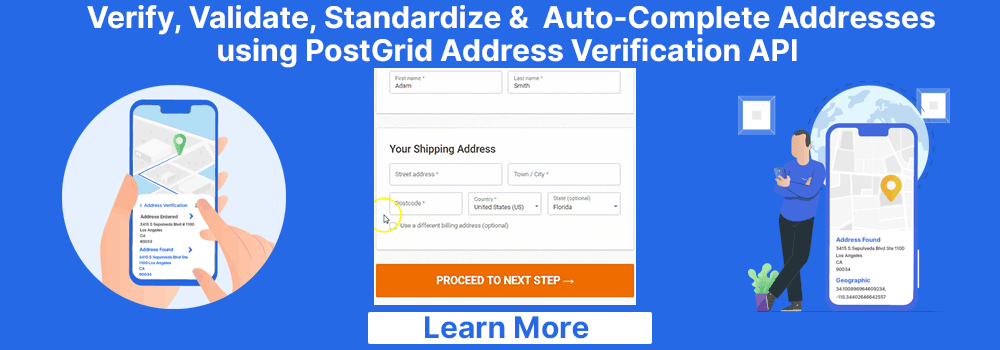What is Transliteration in Address Verification
What Is Transliteration and How to Use it For Effective Address Validation?
Imagine your international business has started getting tons of orders from different countries! With hundreds of orders pouring in each week, you have no idea how to ship these orders as the addresses provided by the customers are written in their native languages.

Most businesses having international customers have a hard time maintaining an accurate database. They struggle with managing mailing addresses written in unfamiliar, foreign languages. If you face such problems too, it is now time to learn what is transliteration.
You may confuse this term with translation, but they are two different concepts. Transliteration allows you to convert foreign delivery addresses into understandable address formats. The process involves swapping or changing text characters from native texts to readable words.
There is no guarantee that you will be able to pronounce these words correctly, but at least you will get your hands on a workable mailing list. This article will help you understand the differences between transliteration and translation. We will also talk about its significance in address verification.
Let’s get started!
How Does Address Verification Work?
Before we get into the translation vs. transliteration debate, let’s know a little about address validation:
Postal verification is a method of confirming the validity and authenticity of mailing lists. It ensures that you send your letters and parcels to the correct recipients. Otherwise, your mailpieces might get lost, misplaced, or returned to you because of incorrect address information.
Remember, it is hard to identify fake or incorrect addresses at the beginning stage. Hence, the USPS might process your items only for them to end up in the wrong hands.
However, address verification can help you avoid such issues by checking every address beforehand. It can help you with standardization, validation, transliteration, and translation. Thankfully, address verification solutions like PostGrid offer all these steps as a single service, helping you save time and costs.
It can help you transliterate mailing addresses from all over the world within minutes. Also, you can ensure that these addresses are formatted according to the destination country’s guidelines for smooth delivery.
What Is Transliteration?
Transliterating is converting a single word or character from one writing system to another. It is done by taking characters or alphabets from one language and finding phonetically-matching alphabets.
For example, グラス is a Japanese word transliterated as “GURASU.”
グ ⇒ GU
ラ ⇒ RA
ス ⇒ SU
In this case, transliterating a Japanese word into an English variable was easy. However, sometimes, you may come across letters that have several transliterations. For instance, the alphabet は can either translate to WA or HA.
Please note: The meaning of the word グラス (GURASU) is glass. But, transliteration does not consider the meaning of any words because its prime purpose is to make them readable in your language. Therefore, translate vs. transliterate are completely varied terms, and we will discuss further on this topic ahead.
Transliteration is not only converting words phonetically. It is also dependent on the country where the language is used. So, what is transliteration example of an alphabet pronounced differently in different countries? Let’s consider the letter Z—Americans pronounce it as ZEE. But, other countries, like the UK, Australia, New Zealand, Canada, etc., pronounce it as ZED.
Similarly, it is pronounced ZETA in Italian and Spanish and ZET in Polish, Romanian, Dutch, and Czech languages. Transliterating letters without knowing the country and language is complicated because there can be several possibilities.
Here’s another interesting fact- transliteration also involves the conversion of numbers. It helps in transliterating apartment numbers, street numbers, ZIP codes, etc., in mailing addresses.
Now that you know what does transliteration mean, you can make a better choice regarding an effective international address verification API. Choose an API like PostGrid that understands that transliteration needs much more effort than phonetic conversion and helps you get it done in minutes.
Differentiating Between Translation Vs. Transliteration
Translation refers to converting native texts or words into their English meanings. For example, when you translate the Japanese word う なぎ, you get its meaning- eel. But, when you transliterate it, you get the word- UNAGI.
You may wonder why transliteration is better than translation. To understand it better, let’s imagine a situation where you need to order food in Japan. The restaurant staff may not understand you when you order yellowtail or Japanese amberjack. It is common as you are using English translations—a language they don’t generally speak. But, if you say HAMACHI which is the transliteration of 鰤, they would understand your order effortlessly.
In our above example, you cannot order HAMACHI unless you know that it means yellowtail. Therefore, you may need transliteration and translation both to understand a word yourself and then explain it to someone else.
Naturally, there are some limitations to transliteration. First, you need to deal with unfamiliar languages without knowing the meaning. For instance, the word Hello translates to こんにちは in Japanese and vice versa. But, this relationship works differently with transliteration. If you transliterate Hello to Japanese, you get the ハロー. But, if you translate ハロー back to English, it becomes HARŌ and not Hello.
Transliteration isn’t a bi-directional process. So, going back and forth between the two languages can lead to a loss of information. Hence, you may feel that knowing what is transliteration is a waste of time. However, it is far from reality as transliteration is a blessing to international companies—helping them enter foreign markets and expand their customer base.
Why Is Transliteration Crucial for Address Validation?
Transliteration helps businesses convert foreign mailing addresses into readable texts facilitating global trade. Such converted addresses enable them to serve their international clients better and complete orders on time—without any language barriers.
Imagine having a database filled with customer addresses from around the globe. If they are stored in your system in their original languages, it can be hard to understand what to do next. Since you don’t know Arabic, French, or Russian, you cannot even locate an address. Here’s when knowing what does transliteration mean can help you out! Let’s see how using an example of a transliterate address:
Chinese: 天津市天津市河北区长张屯村7
Latin Transliteration: 7 ChangZheng TunCun, HeBeiQu, TianJinShi
When you write this address on your mailpiece going to China, it is easy for the USPS workers to process it accurately. Also, since you didn’t translate the address, it is easy for the postal employees in China to understand the address and deliver it to the right person.
PostGrid’s address verification solutions help you transliterate native characters into Latin or English (whenever possible). It also standardizes your addresses correctly, as transliteration might disturb the address format—leading to failed deliveries.
How PostGrid’s Address Verification API Helps You Send International Mail?
Transliteration and translation are helpful components while managing an international database. You may need it often while packing and sending orders to global destinations. Our address validation service can help you capture accurate addresses and transliterate them properly.
Using rooftop geocoding, PostGrid allows you to collect national and international address information in real-time. Thus, you can ensure that only deliverable and correct addresses enter your system. Also, you don’t need to deal with the differences between translation vs. transliteration as we do all the heavy lifting on your behalf.
PostGrid combines address data from almost every postal organization in the world. So, it doesn’t matter if you want to mail a postcard to a local customer or send an order to an overseas location. PostGrid can standardize and verify your address precisely and ensure that your mail reaches the destination without delays or other problems.
With a 99.99% deliverability rate, we take pride in our global address verification service. Furthermore, you can also complete your print and mail tasks using our direct mail automation software. Thus, PostGrid is an all-in-one solution for you to help you:
- Design your mail items
- Print, pack, or stuff them in envelopes
- Assemble and label them
- Mail and track items accurately
Conclusion
Effective address validation assists businesses in converting more leads, minimizing delivery failures, and increasing brand recognition. But, transliteration and translation can make it complicated, which is why you need an automated solution like PostGrid.
Our services are curated to help you tap into foreign markets and reach customers globally. With PostGrid, you can always mail confidently at industry-best pricing. Sign up here to see how PostGrid handles translation vs. transliteration and helps you verify any address in seconds!
Ready to Get Started?
Start transforming and automating your offline communications with PostGrid
The post What is Transliteration in Address Verification appeared first on PostGrid.
source https://www.postgrid.com/what-is-transliteration-in-address-verification/




Comments
Post a Comment